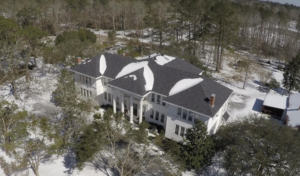
Drone photo by Todd Burnaman less than twenty-four hours before the White House burned.
Saying Goodbye to a Grand Old Lady
Throughout my life in my hometown of Dry Creek, a building has stood that serves not only as a link to the past but as an anchor for our community.
We called it the Dry Creek White House. It had a personality of its own, and we often called it the Grand Old Lady.
Originally built during the years surrounding World War I, it served as our local school from its construction until its closure in 1962. It was built over nearly a decade by the men of the community, and it was constructed sturdily and with great care.
We’ve discussed over the years what style the building was constructed in. When I posted on Facebook a photo of the building, folks came out of the woodwork (pun intended) with everything from antebellum, colonial, to plantation style. I simply will say it was unique.
The Dry Creek (DC) White House clearly had some of the palladin neo-classical structure of the south façade of the other DC (as in District of Columbia) White House.
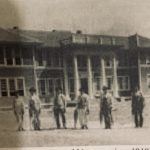
Another fact is that the Dry Creek White House was originally painted brown.
After its years as Dry Creek High School, it remained vacant for the next two decades. A family from Minnesota bought it as a winter home. They didn’t use it much. We always said it was too cold inside even for Northerners. Amazingly, during these empty years, there was no vandalism or broken windows. That’s how the community loved this building.
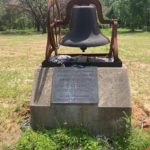
The original school bell
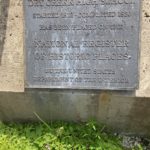
Later, Dry Creek Baptist Camp bought the Old School and renovated it into a bed-and-breakfast-style building with 27 lodging rooms.
Its official name became the Adult Conference Center (ACC), but it was affectionately known as the “Dry Creek White House.”
For the next four decades, the White House hosted hundreds of events and thousands of guests. It was such an interesting facility: 2 stories of 14-foot-high ceilings with rooms of every size and shape. It was my privilege during my 14 years as camp manager to experience and watch so many happy guests, as well as lives changed by God, within its walls.
Unlike most rural schools closed during the 20th century, it wasn’t torn down or allowed to deteriorate through the years. It was given a new lease on life as part of the Camp.
Its use as a facility ended on Wednesday, February 17, 2021, when it burned to the ground. As sad as I am at the loss of the White House, I’m glad it didn’t rot down or be unceremoniously hauled off piece by piece. The Camp gave it a reincarnation of continuing to serve our community and thousands of guests.
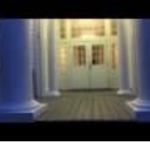
Let me get this out of the way: some folks called this building a “White Elephant.” It was expensive to renovate causing the Camp to take on an enormous debt at a time of high inflation. Secondly, it was difficult to maintain and heat/cool. When someone said to me about it being a white elephant, I’d simply smile and reply, “Yes, it may be a white elephant, but it’s our white elephant.”
I use the term our on purpose. Although the White House was owned by Dry Creek Camp, the entire community felt it belonged to them and loved the building like the way you’d love a grand old lady who had touched lives for nearly a century.
This community ownership meant that everyone in Dry Creek had a specific story to tell about the White House. Camp Manager Todd Burnaman told of countless people, after the fire, sharing in person or online about the building’s place in their lives. They spoke of wedding receptions, how far the school bell could be heard, voting there in local elections, and kids running up and down the carpeted stairs on each end of the White House.
Sam Burchard, pastor of Dry Creek Bible Church and next-door neighbor to the White House said it so well: “I feel as if we should have a funeral.”
It was as if this building was a personal friend and the anchor of our community. Yes, a funeral for a Grand Old Lady might have been appropriate. Last week when I stopped by the ruins of the White House, someone had placed a vase of colorful flowers on each end of its steps.
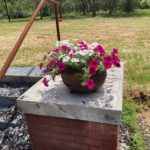
It was someone’s sweet action that a beloved object was gone.
I never attended Dry Creek High School, beginning first grade the year after it closed. Even though the “new school,” East Beauregard, was nice, I was still envious of the older students who told stories of the “old school.” They bragged about climbing the stile during recess and walking to Elliott’s Grocery across the highway. Other stories included tales of sliding down the banisters and how many of the classes were combined because of its small enrollment. If my memory is correct, a total of fewer than four hundred students graduated from 1921–1962. That’s an average of about ten per year. It was a small rural school, and they don’t make them like that anymore.
Don’t discount for a minute the quality of education these students received. Dry Creek graduates thrived/excelled at every level of society.
My Dad always pointed out his first-grade classroom, which eventually became the large conference room: “I was in first grade in that corner.” He recalled, “The second graders were across the room over there. The teacher tag-teamed both grades.” Daddy said that he listened in on the second-grade lessons while doing seatwork. “The next year when I moved across the room to second grade, I’d already heard it all,” he said.
Certain people are tied to my mind when I think about the White House. Here are several of their stories.
My mentor on the history of the old school building was Mr. Frank Miller. Mr. Frank, as we called him, had a unique distinction. He’d been a student, teacher, and principal at Dry Creek High. He loved the old building like the Grand Old Lady it was.
Mr. Frank showed me every inch of the Old School and seemingly had a story for each step. I’ll share my favorite in his own words:
“I was in elementary school as they finished the school. The four hollow columns were hauled in by oxen-drawn wagons from the sawmill at Longville. They were laid down in front of the school and quickly became a recess favorite as the younger boys would crawl through the tunnel of the columns. As this went on for weeks, some high school students played a prank. While several first-grade Dry Creek boys were in the tunnel, the older boys nailed planks over each end of the column. The trapped boys were not discovered and freed until their teacher came outside after recess and heard their crying and yelling.”
As I said, Mr. Frank always had a story for every square foot of the Old School. I still miss him but am glad he wasn’t here to see it burn to the ground.
A second person with a long history of the White House was Mrs. Eleanor Andrews. She faithfully taught elementary there for two decades. Later, she was my fifth-grade teacher at East Beauregard. She became my favorite teacher, and we maintained a close friendship until her death.
Mrs. Eleanor lived by herself not far from the old school. When she turned eighty, she begrudgingly gave permission to plan a birthday party. I insisted we have it at the White House. She scoffed as she flicked ashes off her latest cigarette. “There won’t be anybody come to see an old woman like me.”
In the coming weeks, we planned the party despite her skepticism. I’ll never forget the sunny April Saturday when we held her party. She sat in a chair as a steady procession of former students, friends, and lifetime neighbors paraded by with their well wishes. I’ll always remember her smile as dozens kissed her, hugged her, and left gifts.
When the party finally ended, she turned to me, pointing a bony finger and her stern teacher voice, “You know I’m still mad at you for having this.” Then she broke into the smile I loved so dearly, “But I so enjoyed this. Thank you.”
That smile of this grand old lady who meant so much to all of us is forever etched in my mind. No fire or ashes can erase it. It’ll always be my heart-snapshot-memory when I think of the White House. In spite of the losses, I still smile recalling that day.
Speaking of memories, so many photos, decorations, and mementos burned up. As I heard someone say, “Lots of pictures burned up when the White House burned down. Often I think of items lost that cannot be replaced. Does anyone have another photo of Dry Creek’s famous 1931 state champion basketball team? How will we ever find another Dry Creek Hawks uniform top?
So many things are lost and gone forever.
As I inventory these losses, I think of another woman with a strong connection to the White House. Doris Pate Hennington attended school there, graduating with the last senior class. She met her husband, Roger, in high school, and when they returned to Dry Creek after retirement, she and Roger worked at the Camp.
Mrs. Doris was in charge of cleaning the White House. She took pride in caring for the Grand Old Lady. It was her building, and if anything was amiss, she would immediately report and correct it. Her life was tied up in this building, and her work was a labor of love.
Doris Hennington is one of the first people I thought of when the fire occurred.
When she retired from the Camp, we presented Doris with a plaque commemorating her years of service. It hung in the old school’s former principal’s office among photographs, class lists, and newspaper clippings adorning the wall.
It all burned up when the White House burned down on that cold February afternoon. No source for the fire has been clearly identified. Electricity and water were cut off to the building. We may never know what started the fire.
As I visited with manager Todd Burnaman a month after the fire, I expressed relief that in spite of the great loss, no one was in the building when the fire happened. One of my nightmares as manager was the fear of the building burning while guests were present. We all knew that the rich lighter pine would burn like a torch if a fire ever started.
And that’s exactly how it happened when the White House burned down. Nothing was left except the steps and school bell.
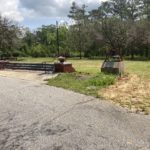
I’ve chosen to celebrate how God used this Grand Old Lady in both of her careers. Over forty years as the community school and then after being abandoned for two decades, she received a facelift and a second career, as a place where people enjoyed comfortable lodging, good food, and fellowship within her walls. The halls of my mind will always echo laughing pajama-clad ladies on Friday nights at women’s retreats. I’ll hold the sound of my Aunt Margie Nell playing the piano there to the delight of numerous guests. She’s chewing gum, tickling the ivories, and catching my eye with a wink and a smile.
In God’s economy, the White House/Old School served its purpose well. It’s gone now. Dry Creek Camp will, in the future, build another adult facility. Someone said they should “build it just like the White House.” My reply is, “You couldn’t build another White House even if you tried. And besides, the new building will be unique and modern, serving others.”
I have one final story.
Each year we hosted a couples’ retreat at the White House. The private rooms with double beds and privacy were perfect for these marriage-enrichment events.
Just before a Fall couples’ event, a woman called wanting to reserve two rooms for the Friday-Saturday event. I carefully inquired, “You and your husband want separate rooms?”
She shared how they’d been separated for most of a year, the result of marital infidelity on his part. What she didn’t say was something I picked up: this was a last-ditch effort to save a faltering marriage.
The couple arrived separately, and to say it was awkward would be an understatement. However, as I observed through the weekend, I detected a thawing in their body language and communication. It was an excellent marriage enrichment led by a fine pastor and wife who taught and showed by example how to make a good marriage even better.
I’m not sure the others knew about the separated couple. I sure didn’t tell, but I prayed. When the couple left on Saturday afternoon, they had hope that maybe, just maybe, their marriage could be rebuilt. The wife later sent a note that they had reconciled, and as I checked in the intervening years, they were still together.
That story illustrates one of a multitude of lives changed by God at the Dry Creek White House.
They are all memories now. I’ll always miss this special building. Like Mr. Frank Miller, Mrs. Eleanor Andrews, and Mrs. Doris Hennington, it played an outsized part in my life. I’m glad God let me in on what He was doing at Dry Creek.
Especially at a Grand Old Lady we called The White House.
Video link of KALB TV interview with Todd Burnaman
https://www.kplctv.com/2021/02/17/historical-building-burns-dry-creek-baptist-camp/
Go Fund Me pages for Dry Creek Camp:
https://www.gofundme.com/f/2ab6dqkaw0?qid=330ae39387557b715863712fae191e5e
https://www.gofundme.com/f/white-house-loss?qid=5759364d07e220db552a32af6bd965b9
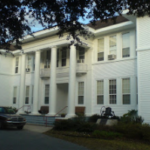
 Creekbank Stories Curt Iles, Storyteller
Creekbank Stories Curt Iles, Storyteller
